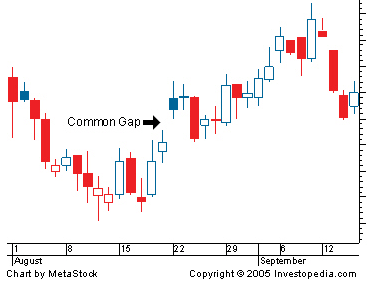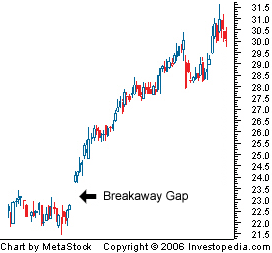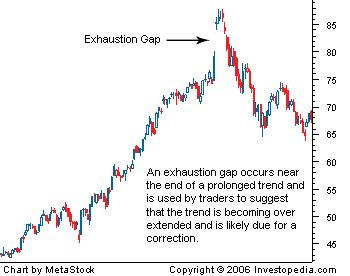(QQQ)(DIA)(GLD)(SPY)(FB)

by DeWayne Reeves
Is Trading the Gap an effective Emini Trading Strategy?
Gap Trading is an area where many traders agree to disagree. While some discount it entirely, others view the "filling of the gap" with a fervor akin to a religious pilgrimage. In this article we will look at both sides of the discussion.
Trading The Gap - An Effective Emini Strategy?
For many traders, the very cornerstone of their trading strategy revolves around whether or not the Gap will fill. Before we continue, let's define what a Gap really is...
Common Gap
A price gap found on a price chart for an asset. These gaps are brought about by normal market forces and, as the name implies, are very common. They are represented graphically by a non-linear jump or drop from one point on the chart to another point.

According to
Investopedia, there is no major event that precedes this type of gap. Common gaps generally get filled relatively quickly (usually within a couple of days) when compared to other types of gaps. Common gaps are also known as "area gaps" or "trading gaps".
Breakaway Gap
A breakaway gap represents a gap in the movement of a stock or other asset such as an Emini Futures contract supported by levels of high volume.

This chart shows a gap at the beginning of a large upward movement. If you chart it, the gap reflects a bullish movement when the price has gapped upwards and a bearish movement when the price has gapped downwards.
Exhaustion Gap
A gap that occurs after the rapid rise in a stock or other asset's price begins to tail off. An exhaustion gap usually reflects falling demand for a particular stock, commodity or futures contract.
This chart shows a gap at the end of a large upward movement, signaling a reversal. Many technical analysts consider the Exhaustion Gap as a temporary gap. The range in prices gapped by the decrease in demand is expected to be filled once demand and the upward pressure on price are re-ignited.
Now that Investopedia has provided us with a clinical description of exactly what a Gap is, the greater questions become:
- Is it tradeable?
- How do I trade it?
- What is the risk vs. reward?
Here's the bottom line - sometimes the gap fills and sometimes it doesn't.
I understand this is a troubling statement but let's get the truth right out in the open.
Sometimes the gap fills and sometimes it doesn't.
Now that I'm assured we're on the same page, let's delve deeper. When the Gap does close, it often does so with such a great sense of purpose and military precision that you no longer want to trade any thing else. Give me the Gap or give me nothing...
And then it doesn't... Why? That's a great question. Seriously, I'm not trying to flatter you, that truly is a great question. The problem is... no one (not even myself or the great and wonderful Oz) knows the answer. I do have a friend, a co-host of this radio program for almost 7 years, who is a very serious Gap Trader. His name is
Mike Reed and most of you know him as the
TradeStalker. He trades the Gap and does it quite well. He will also be the first person to tell you he has no clue as to why it closes on some days and not on others. Here's where it gets interesting -
He doesn't care WHY!
For Mike, the WHY is not important. All the TradeStalker cares about is the WHEN.
Mike's been trading longer than most of you have been wearing long pants. How do I know?
 Check out the date...
Check out the date...
Today it's not too hard to see a Gap, we just look at our charts.
 TradeStalker Hand Drawn Charts
TradeStalker Hand Drawn Charts
When Mike started, it was a bit more challenging. Would you agree? Now the reason I shared this is because I believe it's important to put the following statements in their proper context. You can Google "Gap Trading" 'till your fingers bleed and you will find more content than you can ever consume. However, if you truly have an interest in Trading the Gap, let this be your benchmark. As you can see from the statement above, Mike was trading in 1987 and he's still trading today.
Very few people last that long in this business.
So what does the TradeStalker have to say about Trading the Gap?
A gap up or gap down open is an emotional move, and it often will reverse course and turn in to a "trap open". Gaps that are less than 4 points on the S&P 500 Emini Futures tend to get filled in the same day, especially Tuesday through Thursday. Turns will occur within 20 to 40 minutes after the open. A trader must be on the lookout for a reversal as soon as early momentum is lost.
A gap into a good support /resistance zone (WTZ?) is almost always a good "fade" - with stops no more than 1 point on the other side of the support /resistance zone.
(A "fade" is simply entering a position opposite of the direction of the gap. If the market gapped down, a "fade" would be entering a long position (buying) in to the sell off.)
That's it. I just compressed 27 years of trading experience into 5 minutes. This has nothing to do with theory or an algorithm. On average, this is simply what has happened on every Gap day, day in and day out for the 3 decades. You can question it, ponder it, or turn it into a pie chart. (he really likes Apple) (the pie not the stock) The shelves at Barnes and Noble are filled with great books on trading and the internet is a virtual gateway to webinars and seminars on every trading topic you can possibly imagine. However, if you clicked on this article to simply learn, How To Trade The Gap As An Emini Strategy you now posses the best knowledge on Gap Trading known to man.
Sometimes... less really is MORE!
Over the next few days our Senior Trader and Market Analyst Michael B. will point out the daily opening gaps in the Live Emini Trading Room on all markets from the
S&P to Crude to Gold and many others. Keep in mind that 24 hour Globex markets do not show Gap action the same way a pit traded market does. Simply
APPLY for our
FREE 5 Day Course complete with Charts and Proprietary Emini Indicators and let us show you exactly how it works. The economy is slow, banks are tight, jobs are few. The good news is, the income of an Emini Trader does not rely on any of the above. What does it rely on?
APPLY and find out.
S&P 500 Emini Futures
We seem to spend a lot of time talking about our Weekly Trading Zones don't we?
It has nothing to do with catching tops or bottoms as we seem to be utter failures in that arena. In fact, we don't even try. Our methodolgy almost seems like cheating. (I assure you it's not) We wait for the market to actually make a turn, then... we wait for the turn to be confirmed, then... after most folks have nodded off, we take our trade. (Wake Up!)
The average intra-day swing in the S&P 500 Emini Futures is 3-5 points. Our goal, our methodolgy, our indicators, are designed to simply scoop 2 points out of the middle. No muss, no fuss.
Am I saying "Trading is Easy"?
No!
"But It Can Be Simple!"
How easy? Come find out...
Connect with us: 





Please leave a review on iTunes
5 DAY FREE TRIAL
Emini Podcast for Tuesday 09/18/12
 September 18, 2012 at 10:47 PM
September 18, 2012 at 10:47 PM 
 emini futures,
emini futures,  tradestalker,
tradestalker,  trading the gap
trading the gap 











Reader Comments (1)
Don’t try to step into the world of online trading unless you are totally confident about your binary options experts will never let you lose the game.